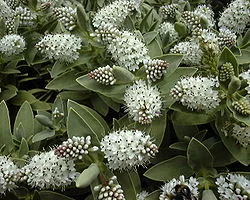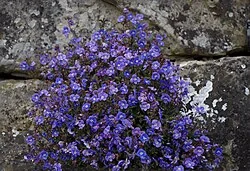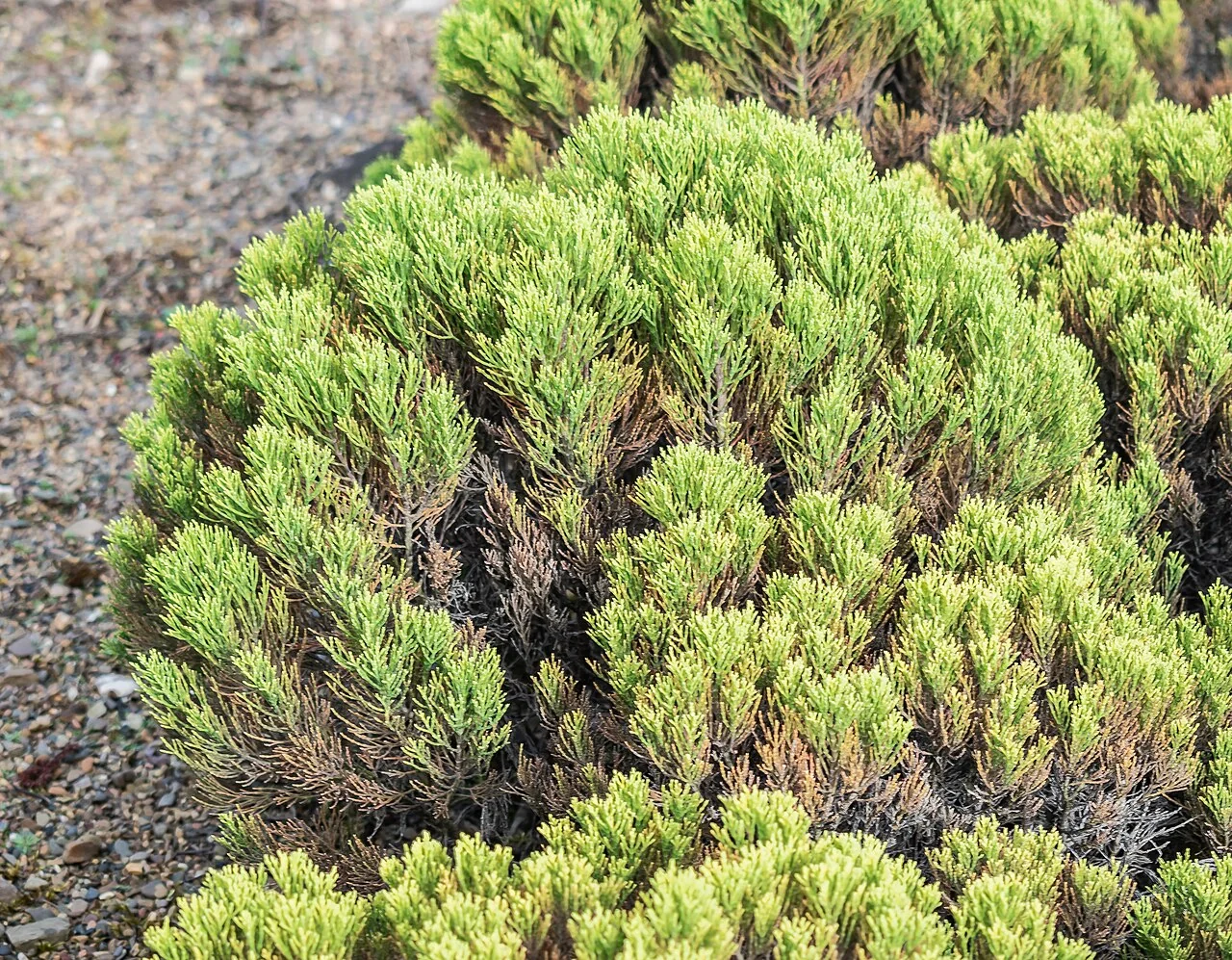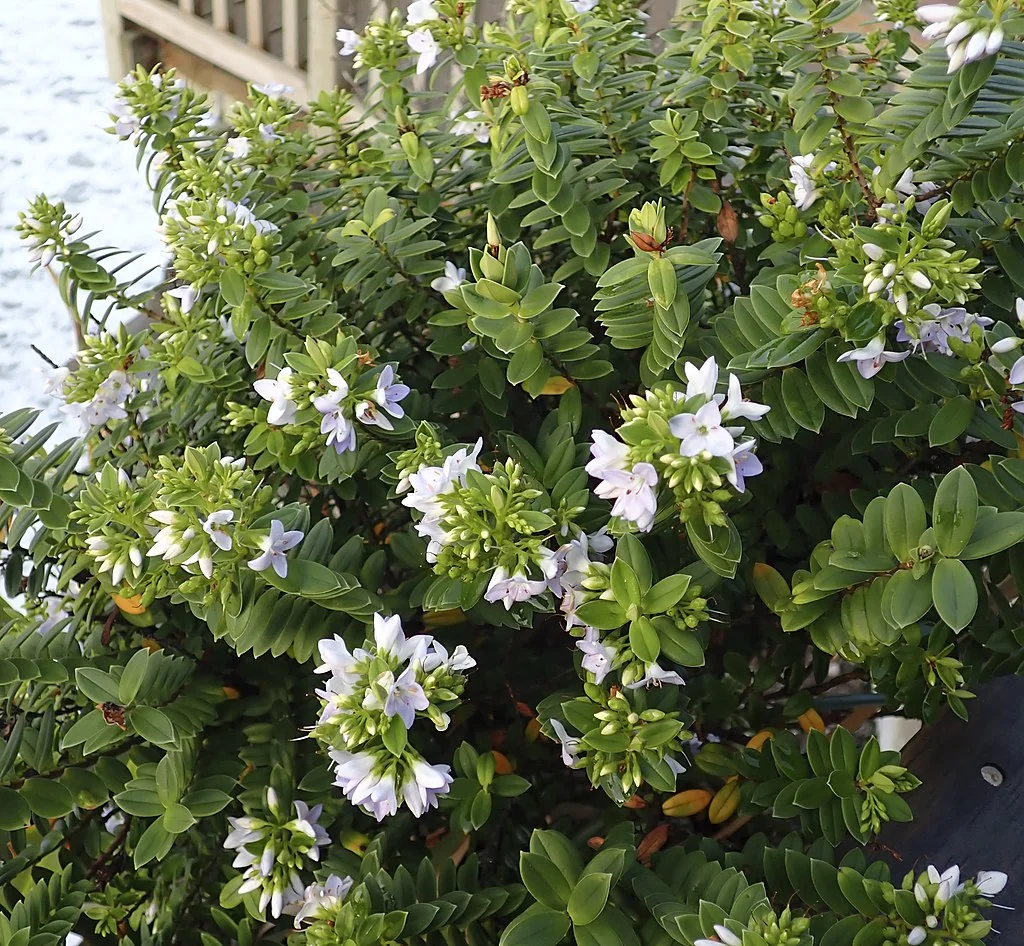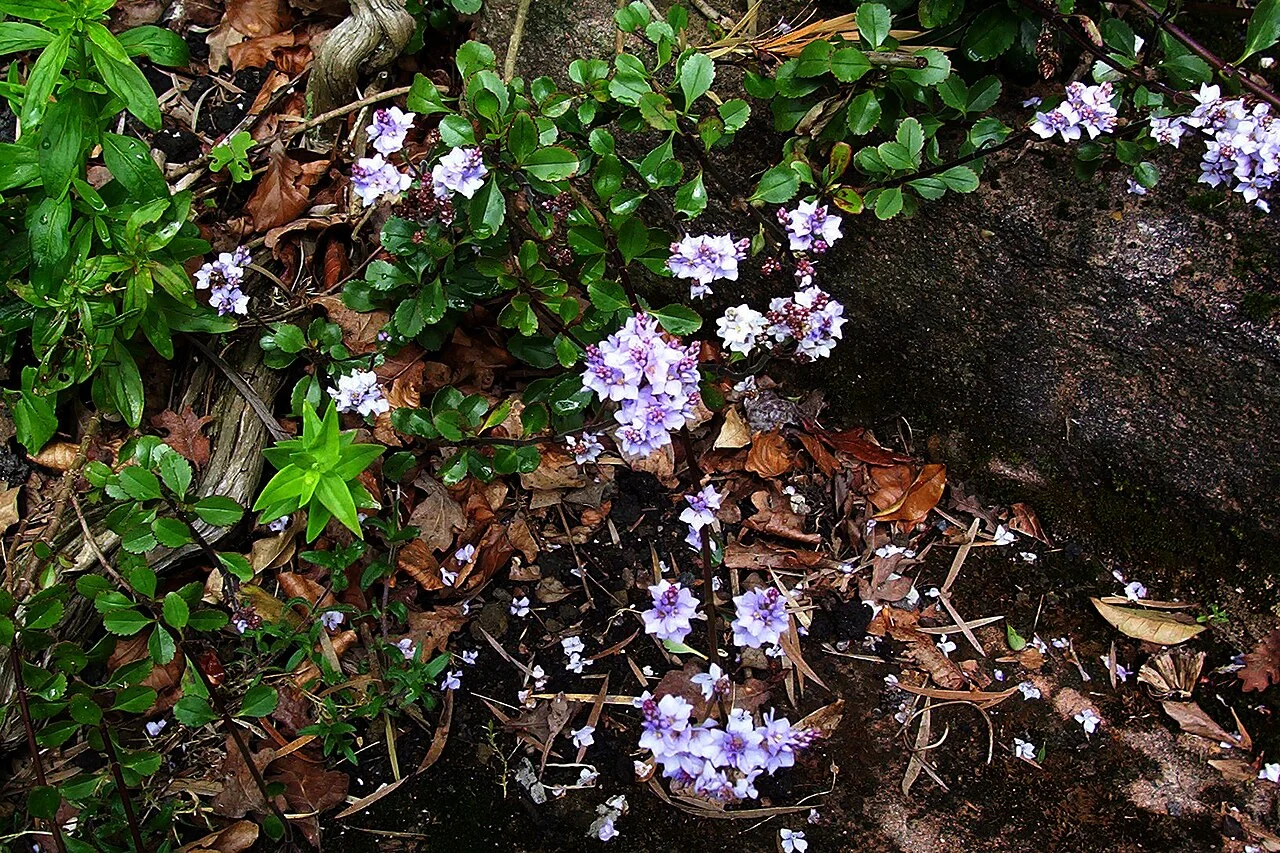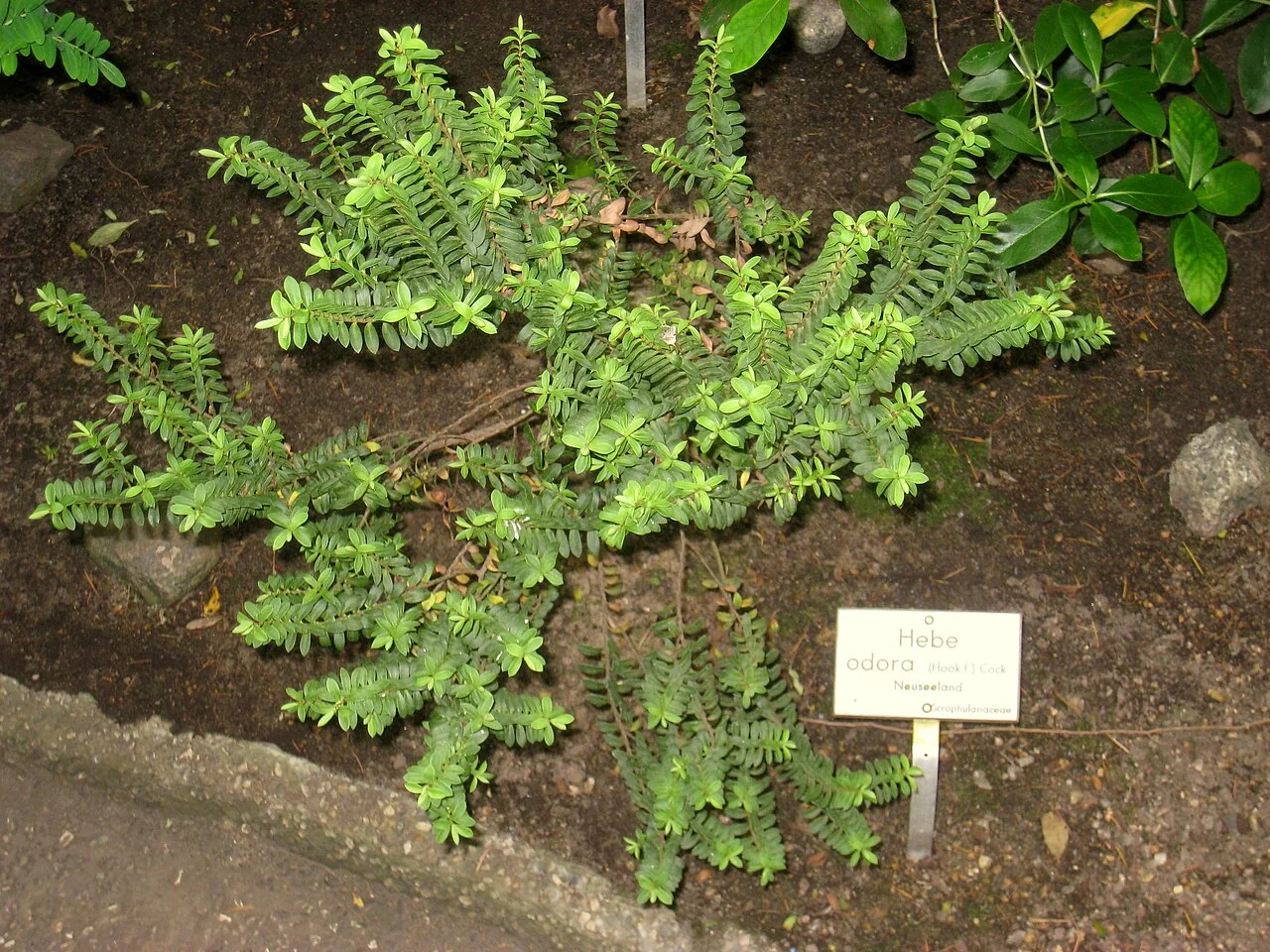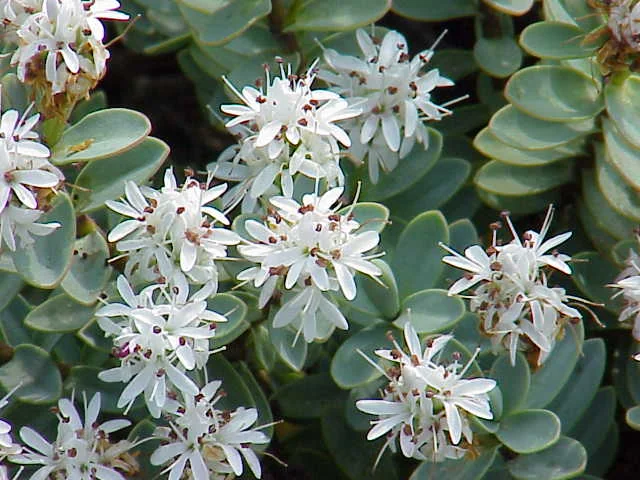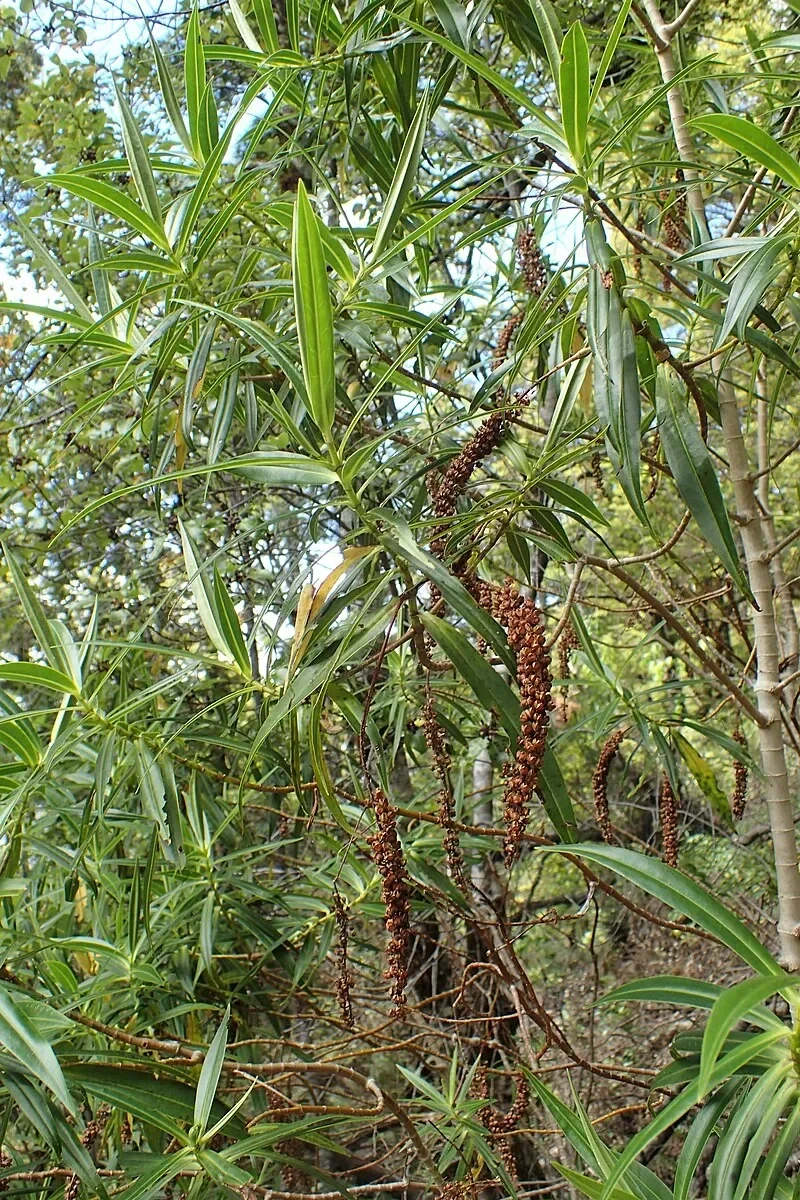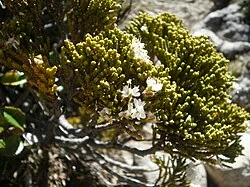
Whipcord Hebe
Veronica tetragona
Veronica tetragona , commonly known as whipcord hebe, is a distinctive subalpine shrub endemic to New Zealand's North Island mountains. This remarkable plant is the only whipcord species found on the North Island, making it a unique representative of New Zealand's alpine flora. Growing 0.6-1 meter tall, it is characterized by its extraordinary four-sided branches that are strongly tetragonal or cruciform in cross-section, giving the plant its scientific name. The dense, scale-like, yellow-green leaves completely surround the stems, creating a distinctive whipcord appearance that sets it apart from all other New Zealand natives. Small white flowers bloom in terminal spikes during summer months, adding seasonal beauty to this architectural plant.

Plant Description
Veronica tetragona is a distinctive hebe with four-angled (tetragonal) stems and tiny scale-like leaves pressed to the shoots, giving a cypress-like texture. Small white flowers appear at shoot tips.
Quick Facts
| Common Names | Whipcord Hebe, Four-sided Hebe |
|---|---|
| Scientific Name | Veronica Tetragona |
| Family | Plantaginaceae (Plantain family) |
| Growth Form | Spreading low or bushy subalpine shrub |
| Height | 0.6-1 m tall |
| Spread | 0.6-1 m wide, forming low spreading mats |
| Distinctive Feature | Four-sided (tetragonal) branches, strongly cruciform in cross-section |
| Leaves | Scale-like, yellow-green, connate, appressed, 2-3.2mm long |
| Flowers | White, in terminal spikes, 2-12 flowers per inflorescence |
| Flowering Time | December - April |
| Fruit Time | January - May (persisting all year) |
| Conservation Status | Not Threatened |
| Distribution | North Island mountains (Raukumara Range to Ruahine Range) |
| Habitat | Subalpine shrubland and penalpine grassland |
| Subspecies | V. t. subsp. tetragona, V. t. subsp. subsimilis |
| Water Needs | Low - drought tolerant once established |
| Light | Full sun to partial shade |
| Soil | Well-drained, poor to moderate fertility |
| Frost Tolerance | Very hardy - tolerates severe alpine frosts |
| Salt Tolerance | Moderate - can handle some coastal exposure |
| Lifespan | Long-lived perennial shrub (20+ years) |
| Growth Rate | Slow to moderate |
| Unique Status | Only whipcord species of North Island |
Climate Best Suited to
Alpine to subalpine in origin - thrives in cool, airy climates; requires excellent drainage and protection from humid summer heat.
Regional Suitability
| City | Climate Suitability |
|---|---|
| Whangārei | Ideal |
| Auckland | Ideal |
| Hamilton | Ideal |
| Tauranga | Ideal |
| Rotorua | Ideal |
| Gisborne | Ideal |
| New Plymouth | Ideal |
| Napier | Ideal |
| Whanganui | Ideal |
| Palmerston North | Ideal |
| Wellington | Ideal |
| Nelson | Ideal |
| Christchurch | Ideal |
| Dunedin | Ideal |
| Invercargill | Ideal |
Natural Habitat
Occurs on exposed, stony ridges, fellfields and subalpine shrublands of the North Island ranges. Plants root among coarse scree and shallow gravel where drainage is immediate, summer nights are cool, and wind and sun keep foliage tight and compact.
Plant Conservation
Conservation Status
Veronica tetragona is classified as "Not Threatened" under the New Zealand Threat Classification System, reflecting its stable populations within its natural range across North Island mountains.
Unique Ecological Significance
As the only whipcord hebe species found on New Zealand's North Island, Veronica tetragona holds special ecological importance. The species exists as two distinct subspecies: V. tetragona subsp. tetragona in the northern ranges, and V. tetragona subsp. subsimilis in the southern mountains, each adapted to slightly different environmental conditions.
This remarkable plant commonly hybridizes with V. odora throughout its range, creating intermediate whipcord-like forms that contribute to the genetic diversity of New Zealand's Veronica complex. These natural hybrids demonstrate the dynamic evolutionary processes still occurring in New Zealand's alpine environments.
Habitat Protection
While not currently threatened, the species' restricted mountain habitat faces ongoing pressures from climate change and human activities. Conservation efforts focus on protecting key subalpine ecosystems and maintaining the genetic integrity of wild populations through careful management of mountain environments.
How to Grow
Planting Guide
Best Planting Practices
Set plants on raised screes, rock walls or mounded beds of sharp grit and coarse sand over free-draining soil. Plant with the crown fractionally high to shed water, then mulch with angular gravel. Water to settle, stake lightly in very windy sites, and space 0.6-0.8 m to showcase the mature outline.
Ecology
Provides nectar and shelter for high-country pollinators, while the densely imbricated foliage creates refuges for alpine invertebrates. The whipcord form is a classic alpine adaptation that reduces transpiration and resists abrasion in persistent wind and ice.
Uses
Whipcord Hebe brings crisp, fine texture to spaces where most shrubs look coarse. It excels in alpine rock gardens, scree beds, raised troughs and exposed terraces, where wind and lean soils keep growth compact. The highly architectural, four-angled shoots contrast beautifully with broad-leaf alpines and silver grasses, and the tidy habit makes it ideal for containers in cool, airy courtyards.
Landscaping Ideas
Combine with red tussock ( Chionochloa rubra ), dwarf Olearia , and silver rosettes of Celmisia for a high‑country palette. Set plants on gritty berms or raised crests so crowns never sit wet, and top‑dress with angular stone mulch to echo its tetragonal stems. In troughs, stage several at differing heights to emphasise the distinctive form.
Seasonal Care
Winter
Ensure perfect drainage and keep crowns slightly elevated to shed meltwater. In heavy snow zones, brush off accumulated snow to prevent branch breakage and check anchors after storms.
Summer
Provide constant airflow and brightest light; avoid humid, enclosed locations. Deeply soak, then allow the gritty mix to breathe between waterings to preserve the tight, whipcord habit.
Pruning
Pruning Techniques
Prune with restraint. After flowering, light tip-prune to maintain outline and encourage fresh, compact shoots. Avoid cutting back into older, leafless wood, which can leave gaps; remove storm-damaged or congested stems to preserve the clean, geometric habit.
How to Grow Whipcord Hebe
Whipcord Hebe grows best when you match its natural habitat: prepare well-drained soil, get the light right, water steadily, and protect from extremes during establishment. Dig wide planting holes, set the crown at original depth, water to settle, and mulch with coarse organic matter to conserve moisture while keeping the stem base dry. Feed lightly in spring; heavy nitrogen is unnecessary and can weaken growth.
Seed
Sow fresh, viable seed on a free-draining mix, cover lightly with fine grit, and keep evenly moist in bright light out of harsh sun. Germination timing varies; prick out once roots hold the media and harden off gradually.
Division
Where the species permits, divide robust clumps in early spring as new growth begins. Replant divisions with several shoots into fresh mix, water thoroughly, and maintain steady moisture until re-established.
Cuttings
For shrubs and many perennials, strike semi-hardwood cuttings in late spring to summer in a coarse, free-draining propagation mix under gentle bottom heat and high humidity. Reduce leaf area, ventilate progressively as roots develop, and pot on before planting out.
After-Care
Maintain an open mulch, irrigate during drought in the first season, and prune or tidy according to the species to build a resilient framework. Adjust shade, wind exposure and watering to prevent stress, and refresh mulch annually for long-term performance.
Pests and Diseases
Common Problems and Solutions
Root rot is the principal risk in poorly drained or warm, humid sites - grow on sharp scree or slopes to keep crowns dry. In heatwaves, spider mites may stipple foliage; increase airflow and rinse with water to deter outbreaks. Fungal spotting indicates stale air; thin lightly and improve exposure to restore vigour.
Cultural Significance
Traditional Uses and Values
Whipcord Hebe holds significant cultural value as a unique representative of New Zealand's distinctive alpine flora. Its extraordinary four-sided branch structure and dense, scale-like foliage make it one of the most architecturally striking plants in New Zealand's native flora, representing millions of years of evolution in isolation.
The plant's unique whipcord growth form has evolved as an adaptation to harsh alpine conditions, with the dense, appressed leaves providing protection from wind, cold, and intense UV radiation at high altitudes. This specialized form demonstrates the remarkable evolutionary adaptations that have occurred in New Zealand's mountain environments.
In modern times, Whipcord Hebe has gained international recognition as an outstanding alpine garden plant, valued by rock garden enthusiasts worldwide for its unusual form and hardy nature. Its cultivation helps preserve genetic material and raises awareness of New Zealand's unique botanical heritage.
The species plays an important role in alpine ecosystem function, providing habitat structure in subalpine shrublands and contributing to the complex plant communities that characterize New Zealand's mountain environments. Its preservation is essential for maintaining the integrity of these specialized ecosystems.
Bonus Tip
Expert Growing Advice
Plant on the sunniest, best-drained scree and water in deep, occasional soaks during dry spells; avoid frequent light watering. This regimen preserves the tight whipcord character and prevents legginess.
